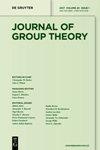Virtual planar braid groups and permutations
IF 0.5
3区 数学
Q4 MATHEMATICS
引用次数: 1
Abstract
Twin groups and virtual twin groups are planar analogues of braid groups and virtual braid groups, respectively. These groups play the role of braid groups in the Alexander–Markov correspondence for the theory of stable isotopy classes of immersed circles on orientable surfaces. Motivated by the general idea of Artin and recent work of Bellingeri and Paris [P. Bellingeri and L. Paris, Virtual braids and permutations,虚拟平面编织群和排列
孪生群和虚拟孪生群分别是编织群和虚拟编织群的平面类似物。这些群在可定向表面上沉圆稳定同位素类理论的Alexander-Markov对应中起辫群的作用。受马丁的总体思想和贝林盖里和帕里斯最近的工作的启发[P。《虚拟辫子和排列》,安。Inst. Fourier (Grenoble) 70(2020), 3,1341 - 1362],我们得到了虚拟双胞胎群与对称群之间同态的完整描述,作为应用,我们得到了虚拟双胞胎群VT n \mathrm{VT} _n在n≥2 n {}\geq 2链上的自同态群的精确结构。这是通过证明在VT n \mathrm{VT} _n内存在一个不可约的直角Coxeter群KT {n}\mathrm{KT} _n{来实现的。作为副产品,还可以得出双胞胎组T n }\mathrm{T} _n{嵌入到虚拟双胞胎组VT n }\mathrm{VT} _n{中,这与编织组的类似结果类似。}
本文章由计算机程序翻译,如有差异,请以英文原文为准。
求助全文
约1分钟内获得全文
求助全文
来源期刊

Journal of Group Theory
数学-数学
CiteScore
1.00
自引率
0.00%
发文量
45
审稿时长
6 months
期刊介绍:
The Journal of Group Theory is devoted to the publication of original research articles in all aspects of group theory. Articles concerning applications of group theory and articles from research areas which have a significant impact on group theory will also be considered.
Topics:
Group Theory-
Representation Theory of Groups-
Computational Aspects of Group Theory-
Combinatorics and Graph Theory-
Algebra and Number Theory
 求助内容:
求助内容: 应助结果提醒方式:
应助结果提醒方式:


